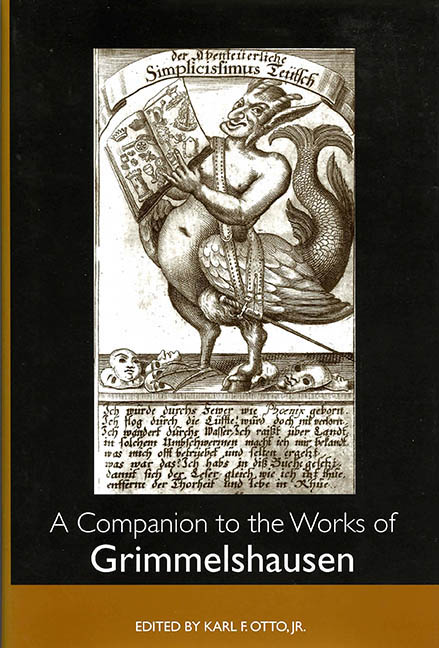Book contents
- Frontmatter
- Contents
- Illustrations
- Acknowledgments
- Chronological List of Grimmelshausen's Works and Their First English Translation
- Introduction
- I Basics
- II Critical Approaches
- Engendering Social Order: From Costume Autobiography to Conversation Games in Grimmelshausen's Simpliciana
- The Poetics of Masquerade: Clothing and the Construction of Social, Religious, and Gender Identity in Grimmelshausen's Simplicissimus
- “To see from these black lines”: The Mise en Livre of the Phoenix Copperplate and Other Grimmelshausen Illustrations
- The Search for Freedom: Grimmelshausen's Simplician Weltanschauung
- Notes on the Contributors
- Index
“To see from these black lines”: The Mise en Livre of the Phoenix Copperplate and Other Grimmelshausen Illustrations
from II - Critical Approaches
Published online by Cambridge University Press: 27 April 2017
- Frontmatter
- Contents
- Illustrations
- Acknowledgments
- Chronological List of Grimmelshausen's Works and Their First English Translation
- Introduction
- I Basics
- II Critical Approaches
- Engendering Social Order: From Costume Autobiography to Conversation Games in Grimmelshausen's Simpliciana
- The Poetics of Masquerade: Clothing and the Construction of Social, Religious, and Gender Identity in Grimmelshausen's Simplicissimus
- “To see from these black lines”: The Mise en Livre of the Phoenix Copperplate and Other Grimmelshausen Illustrations
- The Search for Freedom: Grimmelshausen's Simplician Weltanschauung
- Notes on the Contributors
- Index
Summary
Bey dieser Zeit / ist fast kein Buch verkäufflich / ohne einen Kuppfertitel welcher dem Leser desselben Inhalt nicht nur mit Worten / sondern auch mit einem Gemähld vorbildet. Harsdörffer, Frauenzimmer Gesprächspiele (1646),
Preface to Part VI“Liebes Kind / diese bilder können nicht reden / was aber ihr Tun und Wesen sey / kann ich auß diesen schwartzen Linien sehen / welches man lesen nennet.” (ST 31)
A Simplician Model of Reading
When the illiterate Simplicissimus first encounters the texts of the New Testament, in Book I of Simplicissimus Teutsch (1668), he apprehends them by way of their illustrations. These he anthropomorphizes, confusing pictures with people. He attempts to speak with the book by speaking with the pictured figures. Yet it is the hermit's corrective response that is particularly striking. Pictures and texts, he explains to the naive Simplicissimus, do not figure in a verbal mode, but are rather to be encountered visually: “[…] diese Bilder können nicht reden/ was aber ihr Tun und Wesen sey/ kann ich auß diesen schwartzen Linien sehen/ welches man lesen nennet” (ST 31). From these black lines of print, he explains, thereby lending color and shape to the words on the page, one sees the actions and essence of the pictures. In other words, one comes to know the pictures, according to the hermit, by viewing a disparate set of pictures; namely, the printed letters on the page.
“To see from these black lines” is thus a Simplician model for reading: not the discursive hermeneutics that Simplicissimus himself launched when he began by speaking to the illustrations, but rather a visual engagement with books. Where Simplicissimus treats the pictures discursively, the lesson to be learned is that it is not the pictures that are to be understood and engaged by means of conversation, but rather the words that are to be understood (viewed, literally), in conjunction with pictures. “These black lines” make sense of the pictures. The hermit corrects a hermeneutic reading to an emblematic one: it is by way of accompanying words that one sees the actions and essence of pictures.
Information
- Type
- Chapter
- Information
- A Companion to the Works of Grimmelshausen , pp. 333 - 358Publisher: Boydell & BrewerPrint publication year: 2002
